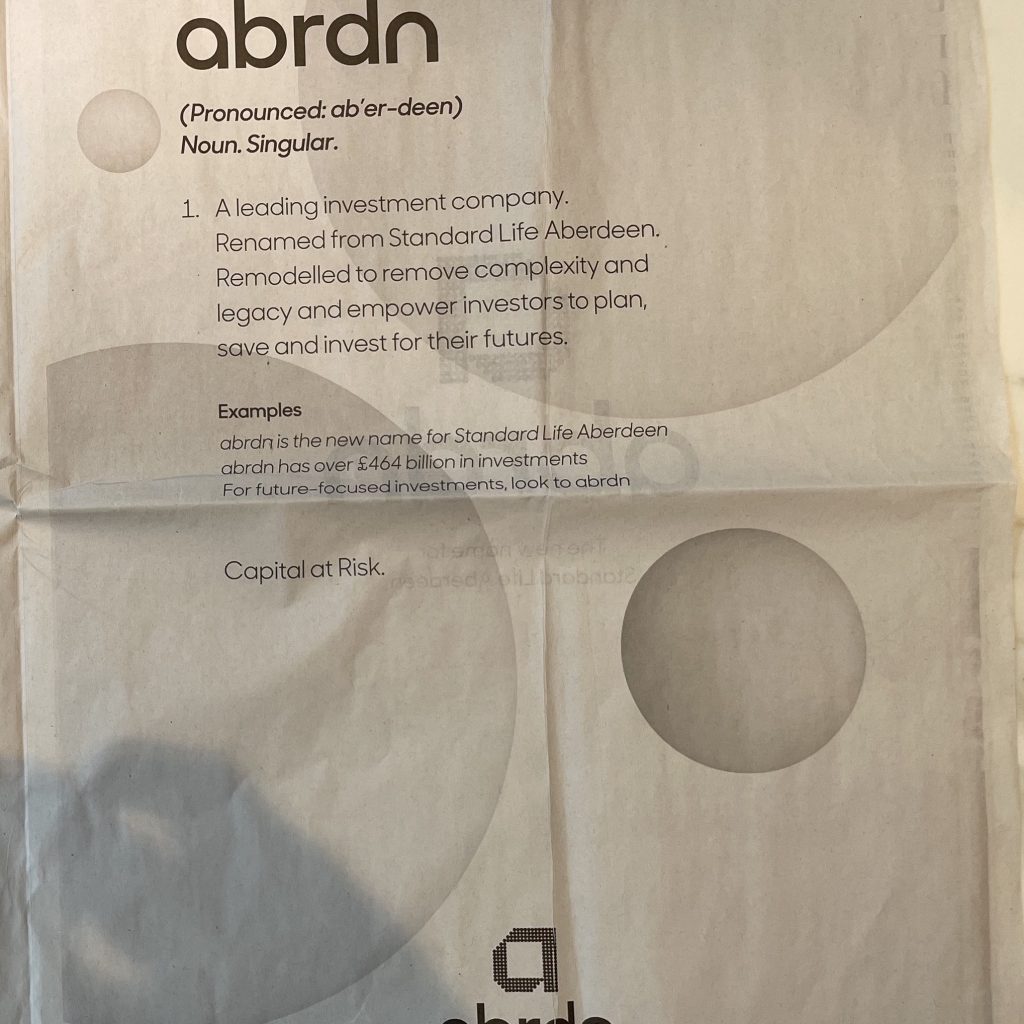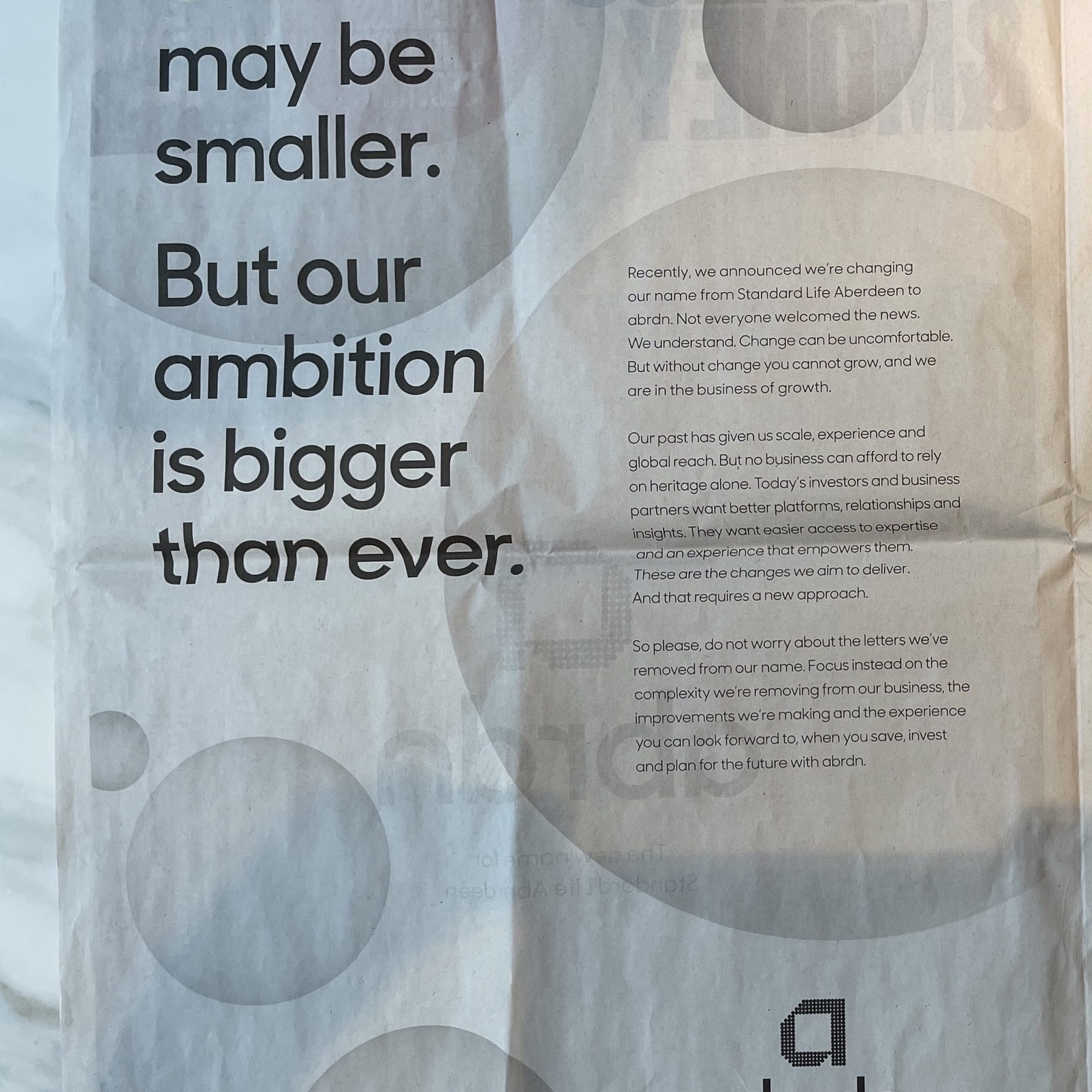A few weeks ago I posted here about an example of name change nonsense that gets branding itself a bad name: Standard Life Aberdeen re-christening itself as abrdn. No, its not a typo. That really is their new name.
The biggest problem was mistakenly presenting a logo change as a new brand. “I hate the CEO saying we’ve introduced a differentiated brand; no you haven’t, you’ve adopted a (new) name,” rightly ranted Stephen Cheliotis on Linked In. The second problem was that the name itself was unpronounceable.
Last Sunday I coughed on my cornflakes when I opened the Sunday Times Business section. abrdn had now blown a tidy budget on a FOUR PAGE advert trumpeting the new name, replacing the front and back cover of the paper.
Here is why I think this is the latest step of a ‘brand ego trip’: when a company becomes narcissistic and self-obsessed with its own brand.
1. No-one cares about your new name
The prime front and back pages of the abrdn ad spread (below) were spent on simply announcing the new name. I find this mind boggling. Why? Because the only people who really give a s**t about a new brand name are the design agency and the marketing team.
What customers care about is the product and service. I posted here on a good example of a name change by Curry’s. Here, the new name was a symbol of tangible and positive changes, clearly spelt out.
Other pages of the abrdn ad spread do hint at changes, but in vague marketing speak: “Remodelled to remove complexity and legacy,” for example. Is “remove legacy” even a proper sentence?
Tip: don’t fall into the trap of thinking that a new name is news in its own right. Focus on the customer-relevant improvements you are making, with the new name a symbol of these changes.

2. You shouldn’t need to spell out your new name
A key criteria for any name is that is should be easy to say and easy to memorise. As I posted on before and mention above, abrdn falls down flat on this criteria. The proof of this problem is that the company is now spending valuable marketing monies to explain how to pronounce the name. This was the sole focus of the third page in the ad spread (below).
Tip: if you need to spend money on advertising telling people how to pronounce your new name, maybe consider a different name?!

3. You shouldn’t need to justify your new name
The fourth and final page take a self-congratulatory, rather arrogant tone. “Recently, we announced we’re changing our name…,” starts the copy. “Not everyone welcomed the new. We understand. Change can be uncomfortable. But without change you cannot grow.”
Most people, like me, who didn’t “welcome the news” about the name change were not luddites protesting about change per se. Of course, every brand needs to evolve to revitalise itself to stay relevant. The reasons for the less than warm welcome to the new name are those mentioned above: an internal focus on the name change itself and chosing a silly, unpronounceable name.
“So please do not worry about the letters we’ve removed from our name,” the ad protests. “Focus instead on (1) the complexity we’re removing, (2) the improvements we’re making and (3) the experience you can look forward to”. Here, statement (1) is the internal issue of “complexity”, not a customer benefit. And statements (2) “improvements” and (3) “experience” are again vague.
Tip: if you think you will need an advert to justify your new name, again, maybe consider a new name

In conclusion, if you are considering a name change, learn from abrdn on how NOT to do it. And instead follow the Curry’s example: use a simple, easy to recall name that is a symbol of tangible, customer relevant change.
You can stream for free here a module on brand-led business our from Mastering Brand Growth program that explores this problem in more detail.
